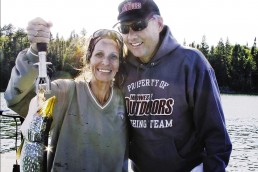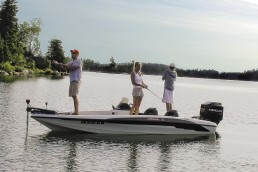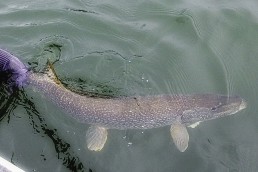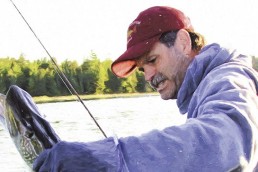How to Catch Fish on Your Canadian Vacation
If there’s one thing that screams pure promise, it’s a beautiful Canadian lake that’s allegedly loaded with fish. You save up a chunk of hard-earned money to rent a cabin at a lodge with waves lapping near the deck, and choose to spend at least a week of your limited vacation attempting to catch some of those alleged fish.
You see other people show up back at the dock with big ones, and photos of big ones. Every winter, you see endless proof that they exist, in scrapbooks handed to you by resort operators lining the halls of winter sports shows.
Yet, somehow, consistency at catching fish eludes you.
You’re struck by the notion that catching fish on purpose is ruled by forces outside of your grasp. You tell yourself that sunsets, quality time on the water, and defending your title in the cribbage championship are what it’s all about. But quietly, you wish you could catch more fish.
Let’s make that happen, this summer.
We aren’t trying to turn you into a touring pro; we just want to help you find some spots that should produce, and help you choose key times of day to focus on fishing. Even if you’re a beginner, following these simple ideas should help you catch fish every day of your trip.
Figuring out a Canadian lake
When it comes to picking apart the personality of a Canadian lake, there are lots of variables, and we could make this complicated if we wanted to. And some lakes won’t fit neatly into the classic profile, because they are dominated by shallow water, or dominated by deep water.
We are going to simplify, and assume that the lakes we’re talking about feature the classic mix of some deeper basins, some shallow bays and some mid-depth flat areas.
Let’s break down what to look for, that will help you find good spots, and tell you what time of day to be out there.
Water clarity
Of all the variables, perhaps the most important is water clarity. Figuring this one out does not require anything other than your own eyes, although polarized sunglasses help when assessing how clear the water is. Glare can mess with the accuracy of your observations.
Biologists use a round disk with black and white paint on it, and lower it until they can’t see it anymore. They carefully measure that and record it as a Secchi disk reading, a measure of how clear the water is. We aren’t going to do any of that. Just head out on the water at midday when the sun is shining and it’s not too windy, and get over spots where you should be able to see things under the water, like weeds, rocks, sunken brush, etc.
Now, using common sense, decide whether the water is really clear, fairly clear, sort of dirty, or so dirty you can’t see much of anything below the surface.
If the water is dirty, try to decide whether it is stained or muddy. Stained water can have a tea-like color, and muddy water looks like chocolate milk. Fish can see things easier, and deeper, in stained water than muddy water.
Here’s what water clarity means, as you try to catch fish.
Clear water
In clear water…
* All things being equal, on a normal day with sunshine, there will be spurts of good fishing action in the early morning through the evening, and potentially even after dark. If you hate getting up early, make sure you plan your day so you go out in the late afternoon and fish until dark. This gives you an advantage, in terms of the mood of the fish.
Most casual anglers who are normal people are sitting around the table playing cards and telling stories after dark, but you can go fishing if you haven’t caught much yet and feel motivated to try it.
If you do want to try night fishing, it’s good to know that only certain species do much feeding after dark. Walleyes, saugers, muskies, crappies, and sometimes largemouth bass can bite good at night. Most other species you’ll encounter on Canadian lakes are snoring, waiting until it gets light enough in the morning to start feeding again.
* All things being equal, you’ll catch more fish in deeper water when it’s clear. This is not universally true, especially when you find good cover, such as weeds or brush, in shallow water––and the shallow water is close to deeper water.
* All things being equal, you should fish deeper during the middle of the day on bright, sunny days. Deeper might mean 12 to 20 or 25 feet deep, rather than 10 feet and less.
Dirty water
In dirty water…
* All things being equal, expect the fishing to be good right smack in the middle of the day, even if the sun is shining brightly. In dirty water, this is when there’s enough light penetration to make it easier for fish to catch their prey.
This is not to say that you could never catch a fish at night in dirty water, because fish can find food using their lateral line sense. Heck, you might catch fish on the bottom in 40 feet of water at night. But follow the general rule and your time will be wisely allocated. Fish dirty-water lakes in the daytime and you should catch plenty of fish.
* All things being equal, you’ll catch a lot of fish in shallow water. In most cases, it comes down to the shallow water having enough light to help predators feed efficiently.
Get away from shore
A huge percentage of vacationers never venture more than a cast-length away from the shoreline, except when they’re boating to a new spot. Indeed, you can catch fish by focusing only on spots with features you can see, like bulrushes and broken rock and downed trees. But if you can see those spots, so can everybody else, and everybody else fishes them nonstop from morning until night, every week, all summer.
Let everybody else be married to the shoreline. You are going to slide out onto mid-depth flats, and catch fish that are less pressured.
The “middle depths” are about 8 feet to maybe 15 feet. Look for places where the middle depths spread across a good-sized area. How big this area is will vary from lake to lake and spot to spot; some lakes don’t have much for mid-depth flats. Other lakes are one big mid-depth flat.
This is not a class in how to read a contour lake map, but here’s the least you need to know, when you’re staring at those confusing lines on the map: find the middle depths, and look for places where the contour lines are farther apart. Those are the flats. If the lines are closer together, they show you steeper drop-offs. Think about this for a second and it will click. They put lines on the map to show you changes in depth. If the depth doesn’t change much for an extended distance, there won’t be any lines.
(Some modern, hyper-accurate maps actually put a new line for every one-foot change in depth, so be aware of this as you decide what constitutes a flat, on the map you’re looking at.)
On most maps, there will be numbers, indicating the depth, in various places. Pick a number, like 10 feet. Find the number 10 on the map, and you’ll see that it’s right on one of the contour lines. If you follow that contour line around on the map, you now know that the water is 10 feet deep everywhere that line goes.
Now, you will be able to find mid-depth flats on any lake map. At this point, one key is to find flats with good weed growth on them. Or, other forms of cover. And now that you understand water clarity, you know that weeds will grow in deeper water on clear-water lakes. At the extreme, cabbage and other weeds can grow as deep as maybe 25 feet. On most clear-water lakes, though, weeds stop growing at 12 to 15 feet.
If you’re looking for something that will make it easy to drive your boat right onto mid-depth flats, then look them over for weeds and other cover, the latest technology is the answer. This past summer, we tested a new unit, the Humminbird Helix 7, and it is a dream to use. You can set the GPS to color-code certain depths of water, revealing mid-depth flats at a glance. Your boat shows up as an icon on the map, so you just drive right to the edge of the flats. The sonar will show you cover, so you know immediately whether the flat has good weeds or not. You can see a lot of things with just your eyes, and can get to mid-depth flats using a sonar unit and paper map, but this is one tool that can change your fishing fortunes. If you’re renting a boat, bring a combo GPS/sonar unit with portable transducer bracket, and slap it on the rental.
Let’s talk more about weeds.
How about weeds?
It’s important to know whether the lake you are fishing has good weed growth or not. Wherever good weeds grow in at least about 3 feet of water, and especially if they grow deeper than that, all sorts of fish will use them, so you should fish in and around them.
Not all lakes have good weed growth, and even on lakes with good weeds, they take a while to get to full flower. From Memorial Day to mid-June, don’t expect to find much in the way of weeds. But from about mid-June into September, finding good weed beds should be a priority.
Cabbage weed is the king, but coontail also holds fish. It all depends on what the lake has. There are many varieties of cabbage, but you don’t have to learn them. Just look for weeds with leaves that look like tobacco and you found ‘em. Coontail, as its name suggests, looks like a raccoon’s tail.
Some modern fishing maps will show areas that traditionally feature good weed growth. But it’s important to know that good crops of weeds do not grow in exactly the same places every year. One year, a certain flat will have great cabbage on it, then the next year, not so great.
The big thing is how little fishing pressure the fish get on flats away from shore. If you spent a day flying around in a plane over a bunch of Canadian lakes, you’d see that most boats are going down stretches of shoreline. The occupants are casting or trolling, but their boat rarely ventures away from the shoreline.
Play the weather
Let’s simplify weather and its impact on fishing, so you can make adjustments during your week of vacation.
Steady weather is a good thing. Constantly changing weather, not so good.
The barometric pressure has a huge impact on how “good” the fish feel, and how actively they move around and feed. If you can, pay attention to it multiple times every day. Watch what it’s doing (whether it’s going up or down, and how fast).
Here’s a good way to think of it, even if the scientists roll their eyes: when the barometric pressure is higher, imagine forces pushing, from all sides, against the fish’s bodies. Picture the fish feeling sluggish and disinterested. If a period of high pressure comes in, but stays for a long time, imagine that the fish adjust to it and go back to living their lives.
Then, as a storm is coming in, when the barometric pressure drops a lot in a short period of time, imagine that the fish are feeling really light on their feet. Fins. Sorry. They feel hungry and ready to party. Even if it’s not the best time to get a suntan, you better get out there on your best mid-depth flats and start casting with everything you have. Fish are going to chase your bait from farther away, and hit it with more gusto. You might start wondering what it would take to get your own fishing show on TV.
Then, after the storm passes and you wake up the next day to bright, sunny skies and perhaps a brisk wind, one look at the barometer will tell you that the pressure is high. Now, imagine that the fish are just laying there, burping up everything they ate yesterday and asking each other if their butt looks big. The fish don’t feel like doing much of anything, and are not likely to chase your bait, much less bite it, even if passes are right in front of them.
If you’re going to take a day and go souvenir shopping, maybe play some mini golf, or just get some sun, this is the day. If you do go fishing, in the words of Al Lindner, “Plan on fishing harder, and slower, for less.”
You can still catch fish, especially pike. Walleyes will be a tougher sell. Shallow-water bass can sometimes go pretty good, especially later in the day. As the weather stabilizes, even if the pressure remains high, the fishing will get better and better each day, until the next storm comes through.
And now you know pretty much what you need to know, to play the weather and put the odds in your favor. And how to find spots likely to hold good fish that are willing to bite. And how to time your outings, based on how clear the water is.
There’s more, so let’s plan to meet again, in the January Canada Fever section.
Note: this is part one of a three-part series on how average anglers can catch lots of fish on their Canadian vacations. Watch for more in the Canada Fever sections in January and February, where we’ll talk lure selection, how to present lures, and much more. To start planning an adventure, check out northwestontario.com, or call 800-665-7567. There is so much water to explore north of the border, and here’s to your best Canadian summer ever.
MWO
SHARE THIS POST
Did you enjoy this post?
You can be among the first to get the latest info on where to go, what to use and how to use it!
Mark Strand
MidWest Outdoors editorial director Mark Strand is a graduate of University of Minnesota School of Journalism with a minor in Fisheries & Wildlife Science. He has written for nearly every outdoor magazine over the past 41 years, and has written or co-written 14 books. In addition to writing and photography, Strand produces the MidWest Outdoors Podcast, and contributes to MWO digital properties. He is an outdoor generalist who loves hunting and fishing of all types. In 2018 Strand was elected to the Minnesota Fishing Hall of Fame.





